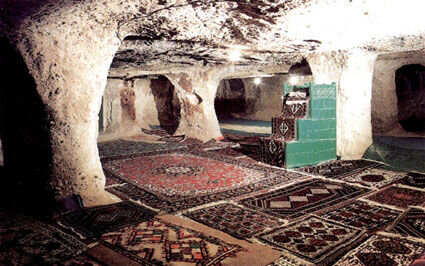Rock-carved mosque in UNESCO-registered Maymand restored

TEHRAN – Restoration work has come to an end on a cozy rock-carved mosque, which is located in the UNESCO-designated Cultural Landscape of Maymand, southern Iran.
The modest mosque was originally a rocky manmade shelter that ancient troglodytes created in Maymand millennia ago.
Those shelters have been carved into mountain-like caves in the continuously inhabited region. The interior spaces have corridors and pillars with rural architecture.
Evidence suggests that the first inhabitants did not use a hammer and chisel, but a type of local pointed stone hard enough to carve images into rocks. This carving method is still practiced in the region. Some of the stone carvings in the village date back 10,000 years.
Nowadays, the majority of inhabitants are semi-nomadic shepherds. They raise animals on mountain pastures, living in temporary settlements in spring and autumn. During the winter months, they live lower down the valley in cave dwellings carved out of the soft rock (kamar), an unusual form of housing in a dry, desert environment.
The community has a strong bond with the natural environment that is expressed in social practices, cultural ceremonies, and religious beliefs. The local dialect contains words from the ancient Sassanid and Pahlavi languages. The dialect has barely changed due to the remoteness of the village.
The area is also home to various animals such as snakes, lizards, hedgehogs, deer, leopards, wolves, foxes, and also birds of prey. Few seasonal springs around the village contribute to the flourishing of agriculture in the area. In such an arid climate, residents have to collect every drop of water to make a living as their ancestors did.
Iran is a haven for ancient troglodytic architecture which is somewhat forgotten though they are filled with life and creativity. The northwest Kandovan village is one of the most famous examples of troglodytic architecture in the country; its ice-cream cone-shaped homes are resembling that of Turkey’s Cappadocia. In 2018, the country hosted the 3rd International Troglodytic Architecture Conference in which tens of experts, researchers, and academia discussed troglodyte-associated architecture, culture, and technology.
In 2015, the Cultural Landscape of Maymand was inscribed on the UNESCO World Heritage list. It is an exemplary system of manmade cave dwellings that is believed to be practiced in the region to cope with its harsh climate.
Maymand Cultural Landscape, as mentioned by the UN cultural body, is an example of a system that appears to have been more widespread in the past and involves the movement of people rather than animals.
AFM
